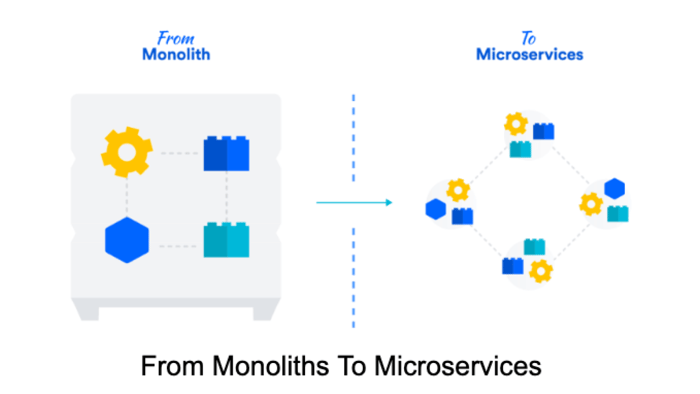Learn tips on how to transition from monoliths to microservices successfully.
Introduction
Once upon a time, a bustling city with towering skyscrapers, interconnected road networks and a thriving economy existed. Everything seemed to flow smoothly, then years later the city's population began to grow, its infrastructure becomes outdated, and congestion starts to take over. A similar analogy can be drawn to the world of software development, where monolithic architectures often face similar challenges.
In the realm of software architecture, monoliths have long been the go-to approach for building applications. These monolithic systems encompass all functionalities within a single, tightly-coupled structure. While they initially serve their purpose, as applications scale and evolve, monoliths often become a bottleneck, hindering agility, scalability, and maintenance.
Recognizing the limitations of monolithic architectures, a modern alternative has emerged – microservices. Microservices are an architectural style that advocates for breaking down applications into smaller, independent services, each catering to a specific business capability. This approach allows for flexible scalability, improved fault isolation, and faster time-to-market.
In this article, we will delve into the fascinating journey of transitioning from monoliths to microservices. We will explore the challenges posed by monolithic architectures, the benefits that microservices bring to the table, and the best practices for successfully migrating to this new paradigm. Whether you are a software developer, architect, or IT professional seeking to modernize your software systems, this article will equip you with valuable insights and practical guidance.
By the end of this article, you will understand the key differences between monolithic and microservices architectures, grasp the benefits and challenges associated with microservices, and gain a clear roadmap for embarking on a successful transition. It's time to unlock the potential of microservices and embark on a journey towards improved scalability, agility, and innovation in software development.
Prerequisite
To fully benefit from this article, it is assumed that you have a basic understanding of monolithic architecture and software development concepts. Familiarity with the following prerequisites will ensure a smoother comprehension of the content:
-
Understanding of Monolithic Architecture: You should be familiar with the concept of monolithic architecture, which refers to a traditional approach where an entire application is built as a single, tightly-coupled unit.
-
Software Development Concepts: Basic knowledge of software development principles, such as modular design, application layers, and the deployment process, will be helpful in understanding the transition to microservices.
-
Software Architecture Fundamentals: A grasp of fundamental software architecture concepts, such as scalability, modularity, and service-oriented architecture (SOA), will provide a solid foundation for comprehending the benefits and challenges of microservices.
What are Monoliths?
Monolithic architecture refers to a traditional approach in software development where an application is built as a single, tightly-coupled unit. In a monolith, all components, functionalities, and services are bundled together into a single codebase and deployed as a single unit.
To better illustrate monoliths, let's consider the example of an ecommerce application in the image above. In this application, customers can browse products, add items to their shopping carts, make payments, and manage inventory. With a monolithic architecture, all these features would be integrated into a single instance of the infrastructure. The monolithic architecture approach means that regardless of how the customers access the application (via desktop or mobile device), and the specific functionality being used, the entire application shares the same codebase and deployment. It often employs a single relational database management system as the central data source.
This tight coupling can have implications for scalability and agility. For instance, if there is a need to update the payment system, it would require modifying and redeploying the entire monolithic application, impacting other components as well.
While monolithic architectures have been widely used and can be suitable for smaller-scale applications or when simplicity is a priority, they can pose challenges as the application grows in size and complexity. The tight coupling between components makes it harder to scale different parts of the application independently or adopt new technologies.
As software development practices evolve, alternative architectural patterns like microservices have gained popularity. These architectures promote modularity and allow different functionalities to be developed and deployed independently, enabling greater scalability and flexibility.
Understanding monolithic architecture is valuable as it provides insights into the historical approach to building applications and lays the foundation for exploring and adopting more modern architectural styles.
Characteristics of Monolithic Architecture
-
Centralized: All modules and components of the application are bundled together and deployed as a single unit.
-
Tight Coupling: In monolithic systems, different modules and components are tightly interconnected. Changes in one module can have unintended effects on other parts of the application, making it challenging to isolate and maintain individual components.
-
Single Codebase: A monolith typically has a single codebase that includes all the logic, features, and dependencies of the application. This makes it convenient for development but can lead to a large, complex codebase that becomes difficult to navigate and manage as the application grows.
Traditional Monolithic Development Approach
In the traditional monolithic development approach, the entire application is designed, developed, tested, and deployed as a single unit. Development teams collaborate on a shared codebase, working on different components or modules within the same code repository. They often utilize a shared database and shared libraries, which are accessed by various functionalities of the application.
This tightly-coupled nature of monolithic architecture allows for easier coordination among team members, as they are all working on the same codebase. However, it also means that any changes or updates to one part of the application may require the entire application to be rebuilt and redeployed.
Challenges Associated with Monolithic Systems
-
Scalability Limitations: Monolithic architectures can pose challenges in scaling the application horizontally, especially during high-traffic or resource-intensive periods. Scaling requires replicating the entire monolith, leading to increased costs and inefficiencies.
-
Lack of Flexibility: Monolithic systems are less flexible when it comes to adopting new technologies, languages, or frameworks. Updating or introducing new features can require modifying the entire codebase, leading to longer development cycles and increased risk.
-
Complex Maintenance: Maintaining and debugging monolithic applications can be complex due to the interconnected nature of the components. A small change or bug fix can have unintended consequences throughout the system, making it time-consuming and error-prone.
-
Deployment Challenges: Updating or deploying new features in a monolith often requires downtime or interruption to the entire application. This can impact user experience and hinder the ability to deliver updates quickly and independently.
What are Microservices?
Microservices architecture is an approach to software development that structures an application as a collection of small, autonomous services that work together to fulfil specific business functions. Each service focuses on a single, well-defined task and can be developed, deployed, and scaled independently. This architectural style promotes loose coupling and allows for flexibility and agility in building and maintaining complex applications.
Microservices are designed to be modular, with each service encapsulating a specific business capability. This modularity enables developers to work on individual services independently, using different technologies and programming languages suited to the specific task. The services communicate with each other through well-defined APIs, using lightweight protocols such as HTTP or messaging queues.
In the context of an ecommerce application, we can consider separate microservices for payment processing, shopping cart management, inventory management, and a user interface (UI) microservice. Each microservice handles a distinct function and can be developed, deployed, and scaled independently.
For example, the payment microservice would handle payment transactions, integrating with payment gateways and ensuring secure transactions. The shopping cart microservice would manage the customer's shopping cart, enabling adding, removing, and updating items. The inventory microservice would handle inventory management, tracking product availability and stock levels. Also, the UI microservice would provide the user interface layer, presenting a seamless experience to users and orchestrating communication between the different microservices.
By breaking down the application into microservices, developers can focus on specific functionalities and make changes or updates without impacting the entire system. This allows for easier maintenance, scalability, and the adoption of different technologies for each microservice as needed. Additionally, if one microservice experiences high traffic or requires additional resources, it can be scaled independently without affecting other parts of the application.
With the nature of Microservices, we can come to the conclusion that it is of more benefit than monolithic systems. Here are some benefits of using microservices:
-
Scalability: Microservices allow for horizontal scalability, where specific services can be scaled independently based on demand. This enables efficient resource utilization and better performance.
-
Flexibility: Each microservice can be developed, deployed, and updated independently, providing flexibility in the development process. Changes in one service do not necessarily impact others, facilitating faster iterations and reducing the risk of regression.
-
Independent Deployment: Microservices can be deployed and updated individually without affecting the entire application. This allows for continuous deployment and faster time-to-market for new features or bug fixes.
-
Failure Isolation: In a microservices architecture, if one service fails, it does not necessarily affect the entire application. Services can be designed with fault tolerance and resilience, ensuring that failures are isolated and do not propagate.
-
Team Autonomy: Microservices architecture allows for smaller, autonomous development teams to work on individual services. This autonomy enables teams to move faster, make independent decisions, and take ownership of their services, fostering a culture of innovation and accountability.
By adopting microservices, organizations can create more agile and resilient systems that can adapt and scale with the evolving needs of modern software development.
Refactoring a Monolith into Microservices
Transitioning from monoliths to microservices requires careful planning and a systematic approach. Let’s explore the process of refactoring a monolithic architecture into a microservices-based system. Here are some key steps and strategies for a successful migration:
-
Analyzing the Existing Monolithic System: Before embarking on the transition, it is crucial to analyze the existing monolithic system. This involves understanding its functionalities, dependencies, and potential areas for improvement. By identifying the bounded contexts within the monolith, you can determine the logical boundaries for extracting microservices.
-
Identifying Bounded Contexts: Bounded contexts are specific areas within the monolith that can be considered as separate units of functionality. These contexts should have clear boundaries and represent cohesive business capabilities. By identifying bounded contexts, you can define the initial scope for extracting microservices, ensuring that each microservice focuses on a specific and well-defined domain.
-
Breaking Down the Monolith: To break down the monolith, several strategies can be employed:
-
Strangler Pattern: This approach involves gradually replacing functionality within the monolith with microservices. New features and functionalities are developed as microservices, while the existing monolithic components are gradually phased out. This strategy allows for a step-by-step transition without disrupting the entire system.
-
Domain-Driven Design (DDD): DDD principles can guide the identification of bounded contexts and the design of microservices. By focusing on domain modelling and the relationships between entities, DDD helps in creating well-structured and loosely coupled microservices.
-
Event-Driven Architecture (EDA): In an event-driven approach, microservices communicate through asynchronous events. This enables loose coupling and flexibility, as each microservice reacts to events and performs its specific tasks. EDA can be a suitable strategy for breaking down a monolith into smaller, independent services.
-
API Gateway: Implementing an API gateway can serve as a single entry point for all client requests. The API gateway can then route these requests to the respective microservices, abstracting the complexity of the underlying architecture and providing a unified interface.
-
-
Ensuring Data Management and Communication: As microservices communicate with each other, considerations for data management and inter-service communication are crucial. Implementing techniques such as event sourcing, CQRS (Command Query Responsibility Segregation), and asynchronous messaging can facilitate efficient data flow and decoupled communication between microservices.
By following these steps and employing the appropriate strategies, the process of refactoring a monolith into microservices becomes more manageable. However, it's important to note that this process requires careful planning, testing, and monitoring to ensure a successful transition.
When and When Not to Use Monoliths
While microservices architecture offers numerous benefits, there are still scenarios where the monolithic architecture remains a suitable choice. Let’s get a scope on when it is appropriate to use monoliths and discuss considerations for making that decision.
When to Use Monoliths
-
Small-Scale Applications: For small-scale applications with limited functionality and a small development team, a monolithic architecture can be a pragmatic choice. The simplicity of a monolith can expedite development and reduce overhead, making it easier to manage and maintain.
-
Limited Resources: In projects with constrained resources, such as tight budgets or time constraints, a monolithic architecture can be a more practical option. Developing and deploying a monolithic application requires less infrastructure and operational overhead compared to microservices.
-
Single-Purpose Applications: If the application serves a specific, well-defined purpose and does not require extensive integrations or interactions with other systems, a monolith can provide sufficient functionality without the need for the additional complexity of microservices.
When Not to Use Monoliths
-
Scalability and Performance Requirements: If an application requires frequent scalability or has performance-critical components, a monolithic architecture may not be suitable. Microservices' ability to scale individual services independently and optimize performance for specific components makes them a better choice for such scenarios.
-
Flexibility and Technology Diversity: If an application demands the use of different technologies or frameworks for different functionalities, a monolithic architecture may limit the team's flexibility. Microservices allow for the adoption of diverse technologies, enabling teams to choose the best tool for each specific business capability.
-
Decentralized Development and Deployment: If multiple teams are working on different parts of the application independently, a monolithic architecture may hinder their autonomy. Microservices' independent deployment and development enable teams to work on their respective services without tight coupling, fostering agility and innovation.
It's important to carefully consider the specific requirements, project scope, and available resources when deciding whether to use a monolithic architecture. Evaluating scalability needs, project complexity, and team structure will help determine which architectural approach best aligns with the application's goals.
When and When Not to Use Microservices
Microservices architecture has gained significant popularity in recent years due to its ability to address the challenges of scalability and flexibility. However, it is important to understand when microservices are a suitable choice and when alternative architectural approaches may be more appropriate. Let’s look at scenarios where microservices excel and discuss considerations for their adoption.
When to Use Microservices
-
Large-Scale Applications: Microservices architecture is well-suited for large-scale applications with complex business domains. By breaking down the system into smaller, independently deployable services, teams can effectively manage and scale individual components based on demand.
-
Complex Business Domains: If an application involves multiple business domains that require separate development and deployment lifecycles, microservices can provide better separation of concerns. Each microservice can focus on a specific domain, enabling teams to work autonomously and independently to evolve their services.
-
Technology Diversity and Polyglot Persistence: Microservices offer the flexibility to use different technologies, frameworks, and programming languages within the same application. This allows teams to leverage the most appropriate tools for each service, promoting technological diversity and the use of specialized solutions.
When Not to Use Microservices
-
Small-Scale Applications: For simple applications with limited functionality and a small user base, adopting a microservices architecture may introduce unnecessary complexity and overhead. A monolithic architecture can be a more pragmatic choice in such scenarios.
-
Limited Development Resources: Microservices introduce additional operational complexity, requiring teams to manage multiple services, orchestrate inter-service communication, and ensure fault tolerance. If a project has limited development resources or lacks the necessary expertise, a monolithic architecture may be a more manageable option.
-
Minimal Inter-Service Communication: If an application does not require extensive inter-service communication or relies heavily on single core functionality, the overhead of microservices may outweigh the benefits. A monolithic architecture can be simpler to develop, deploy, and maintain in such cases.
The decision to adopt microservices should be carefully evaluated based on the specific needs and constraints of the project. Consider factors such as application size, complexity, scalability requirements, team capabilities, and the potential operational overhead. Striking the right balance between the benefits of microservices and the associated challenges is crucial for a successful implementation.
While microservices have gained popularity and are often considered a modern approach to software architecture, it's worth noting that there is no one-size-fits-all solution. Recently, the Amazon Prime Video team expressed their preference for monolithic architectures over AWS Serverless, saying “Monoliths are sexy again”.
Ultimately, there is no definitive answer as to which architectural style is universally better. The decision should be driven by a thorough understanding of your project's unique needs and the capabilities and preferences of your development team.
Conclusion
In conclusion, transitioning from monoliths to microservices can unlock numerous benefits, including improved scalability, agility, and better alignment with modern software development practices. However, it is crucial for you to thoroughly assess their specific needs and constraints before making architectural decisions. Each project is unique, and choosing the right architecture requires careful consideration of the trade-offs involved.
By embracing a thoughtful and informed approach, developers, architects, and IT professionals can successfully navigate the transition from monoliths to microservices, unlocking the full potential of modern software systems.
Remember, the path to microservices should be guided by your project's goals, scalability requirements, available resources, and the complexity of your business domains. May your architectural journey be filled with successful transitions and optimized software systems.
Akava would love to help your organization adapt, evolve and innovate your modernization initiatives. If you’re looking to discuss, strategize or implement any of these processes, reach out to [email protected] and reference this post.





